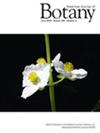The spatial distribution of a hummingbird-pollinated plant is not strongly influenced by hummingbird abundance
Abstract
Premise
Many angiosperms have evolved specialized systems that promote pollination by specific taxa. Therefore, plant distributions may be limited by the local abundance of their specialist pollinators. In eastern North America, Lobelia cardinalis is thought to be pollinated solely by Archilochus colubris, the only hummingbird species found in the region. Here we tested the hypothesis that the distribution of a plant species with specialized pollination is controlled by the range and abundance of its specialist pollinator.
Methods
We investigated the importance of A. colubris abundance, sourced from eBird, as a variable in a MaxEnt species distribution model of L. cardinalis using presence data from iNaturalist. We also compared hummingbird abundance between locations of L. cardinalis and congeneric during their respective flowering periods and explored whether the flowering periods of L. cardinalis and congenerics align with the week of peak local hummingbird abundance.
Results
Unexpectedly, MaxEnt modelling did not suggest that A. colubris abundance is a key driver of the species distribution. Lobelia cardinalis habitat suitability was lowest in the absence of A. colubris and increased with increasing abundance, but habitat suitability was also low in regions where hummingbird abundance is highest. Still, hummingbird abundance at L. cardinalis locations was generally higher than most congenerics, and L. cardinalis tended to flower near the week of local peak A. colubris abundance.
Conclusions
While populations of hummingbird-pollinated plant species may require the local presence of hummingbirds, fine-scale variation in hummingbird abundance may not strongly influence their spatial distributions.





 求助内容:
求助内容: 应助结果提醒方式:
应助结果提醒方式:


